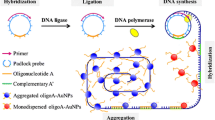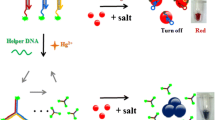Abstract
Cypridina luciferase is a bioluminescent enzyme that has been used as a reporter either in gene expression reporter assays or in immunoassays accompanied by an antibody. To develop a novel bioluminescent assay for the detection of 5-hydroxymethylcytosine, we first conjugated Cypridina luciferase to the antibody against 5-hydroxymethylcytosine. Next, we performed modifications of guanine bases in the genome DNA samples with 4-azidophenylglyoxal and the biotinylation via the azide-Staudinger ligation, which allowed streptavidin to capture and immobilize the genome DNA samples under mild conditions. The detection of 5-hydroxymethylcytosine in the genome DNA samples was performed with the conjugates between Cypridina luciferase and the reduced antibody, which was also confirmed by a surface plasmon resonance assay with the antibody alone. The results obtained from the bioluminescent assay were in good agreement with that of the surface plasmon resonance assay. We succeeded in the detection of 5hmC in the genome DNA samples from the dinoflagellate Pyrocystis Lunula by using this method.
Similar content being viewed by others
References
J. U. Guo, Y. Su, C. Zhong, G. L. Ming, and H. Song, Cell, 2011, 145, 423.
K. Tanaka and A. Okamoto, Bioorg. Med. Chem. Lett., 2007, 17, 1912.
M. Foksinski, E. Zarakowska, D. Gackowski, M. Skonieczna, K. Gajda, D. Hudy, A. Szpila, K. Bialkowski, M. Starczak, A. Labejszo, J. Czyz, J. Rzeszowska-Wolny, and R. Olinski, PLoS One, 2017, 12, 1.
D. Liu, C. Zhao, and H. Wang, Anal. Sci., 2016, 32, 963.
B. Chowdhury, I. H. Cho, N. Hahn, and J. Irudayaraj, Anal. Chim. Acta, 2014, 852, 212.
W. Jiang, L. Wu, J. Duan, H. Yin, and S. Ai, Biosens. Bioelectron., 2018, 99, 660.
K. Hasegawa, M. Matsumoto, K. Hosokawa, and M. Maeda, Anal. Sci., 2016, 32, 603.
C. Wu, C. Suzuki-Ogoh, and Y. Ohmiya, Biotechniques, 2007, 42, 290.
C. Wu, K. Kawasaki, Y. Ogawa, Y. Yoshida, S. Ohgiya, and Y. Ohmiya, Anal. Chem., 2007, 79, 1634.
C. Wu, K. Mino, H. Akimoto, M. Kawabata, K. Nakamura, M. Ozaki, and Y. Ohmiya, Proc. Natl. Acad. Sci. U. S. A., 2009, 106, 15599.
M. Staehelin, Biochim. Biophys. Acta, 1959, 31, 448.
S. C. B. Gopinath, Anal. Chim. Acta, 2009, 636, 117.
M. Kai, S. Kishida, and K. Sakai, Anal. Chim. Acta, 1999, 381, 155.
S. Yamasaki, S. Yamada, H. Takemura, and K. Takehara, Anal. Sci., 2017, 33, 307.
N. Kuroda, K. Nakashima, and S. Akiyama, Anal. Chim. Acta, 1993, 278, 275.
C. Wu, J. Anal. Methods Chem., 2016, 2016.
S. Lin, Res. Microbiol., 2011, 162, 551.
T. Kurinomaru, N. Kojima, and R. Kurita, Chem. Commun., 2017, 53, 8308.
Acknowledgments
This study was supported in part by a Grant-in-aid (grant no. 18K051951 to C. W.; 18K14258 to T. K.) from the Ministry of Education, Culture, Sports, Science, and Technology, Japan. We thank the national institute for environmental studies for supplying the dinoflagellate Pyrocystis Lunula (NIES-609).
Author information
Authors and Affiliations
Corresponding author
Rights and permissions
About this article
Cite this article
Wu, C., Kurinomaru, T. Development of the Bioluminescent Immunoassay for the Detection of 5-Hydroxymethylcytosine in Dinoflagellate. ANAL. SCI. 35, 301–305 (2019). https://doi.org/10.2116/analsci.18P401
Received:
Accepted:
Published:
Issue Date:
DOI: https://doi.org/10.2116/analsci.18P401




